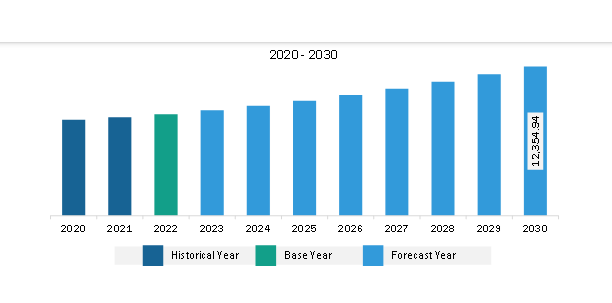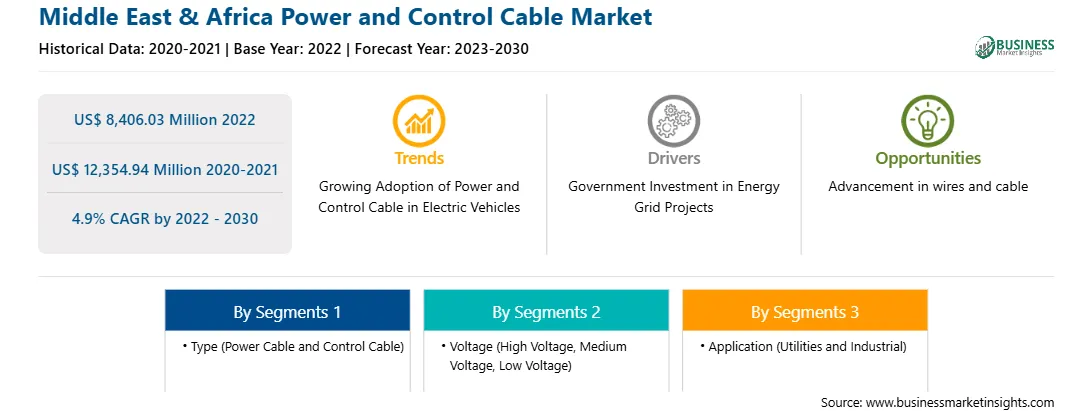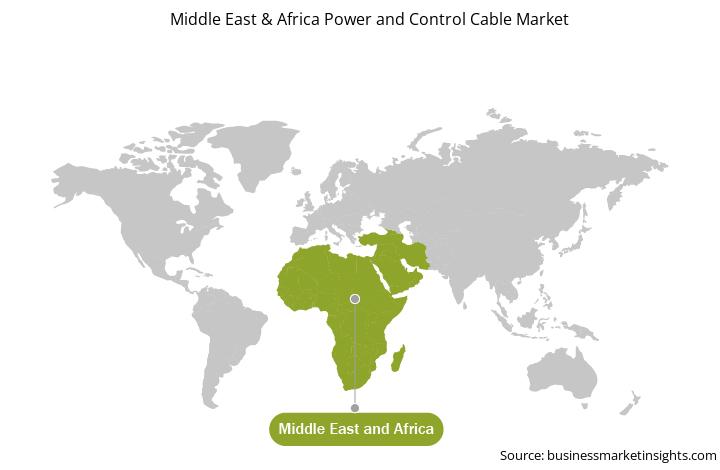The Middle East & Africa power and control cable market was valued at US$ 8,406.03 million in 2022 and is expected to reach US$ 12,354.94 million by 2030; it is estimated to grow at a CAGR of 4.9% from 2022 to 2030.
Increasing Demand for Data Center and Cloud Computing Fuels the Middle East & Africa Power and Control Cable Market
The growth of data centers and technology-driven industries propelled the need for power and control cables to ensure uninterrupted power supply and data transmission. The cables are crucial to maintain the functioning of critical infrastructure. As the demand for data storage and processing continues to rise, more data centers are being built. These facilities require extensive power and control cable systems to distribute electricity and manage various systems and equipment. Modern data centers are designed to accommodate high-power-density servers and equipment. This generates a huge scope for power cable systems capable of handling larger electrical loads safely and efficiently. Lately, several data centers have been installed. In 2023, Egypt's Ministry of Communications and Information Technology and the UAE Ministry of Investment signed an MOU to invest in Egypt's digital infrastructure through 1GW of data center projects. Also, Edgnex Data Centers have signed a new collaboration deal to construct a data center and Cinturion, a cable landing station (CLS) in Saudi Arabia. Also, in 2022, to expand its presence on the African continent, Equinix, Inc. announced plans to join the South African market with a US$ 160 million data center investment in Johannesburg. Therefore, the growing data center industry relies heavily on power and control cables to ensure reliable, efficient, and safe operations. As data centers evolve and expand, the demand for these cables is expected to increase significantly in the coming years.
Middle East & Africa Power and Control Cable Market Overview
The infrastructure sector in the MEA is growing significantly. Several Middle Eastern countries seek diversification of their country's income source and focus on developing infrastructure in different sectors. The energy sector is one of the most promising sectors in the region. For instance, the UAE government plans to revisit its energy strategy to attract more investments in solar energy and green hydrogen projects. It has set a target to propel its renewables capacity at an annual average rate of 16.7% from 2021 to 2030 to meet the 11.3% of the power mix target by 2030.
Saudi Arabia is one the largest spenders on infrastructure in the Middle East and is witnessing an unprecedented rise in the number of construction and urban mega projects. Approximately 200 small, medium, and large infrastructure projects are at different stages of completion or implementation under the country's public-private partnership (PPP) model. A few of the prime examples of infrastructure development projects include the 400 MW capacity Dumat Al-Jundal wind farm and the 2.65GW Ras Al-Khair power and water plant. The government also plans to set up projects to generate 10 GW of renewable energy and ~50% of its power requirements from renewable sources by 2030. The NEOM Green Hydrogen plant being constructed for US$ 8.4 billion is the world's largest green hydrogen plant that will produce green ammonia on a large scale. The plant is expected to utilize up to 4GW of wind and solar energy for producing approximately 600 metric ton/day of carbon-free hydrogen by the end of 2026.
Similarly, as part of Bahrain's 2021 Economic Recovery Plan, the government announced over 22 strategic infrastructure projects worth more than US$ 30 billion, including the construction of five artificial islands in the PPP model. Such emphasis on infrastructure development is aligned with the Kingdom's Vision 2030 economic development strategy. The approach seeks to improve infrastructure, industry, housing, and connectivity and thus requires a more diverse economic base, with broader industrialization, training, and education of the national workforce. All such factors are driving the Middle East & Africa power and control cable market in the region.
Demand for energy consumption in Africa is anticipated to grow rapidly in the coming years. Africa presently has the world's lowest per capita use of modern energy. The African utilities sector is characterized by its large geography, limited interconnection, improving electrification, and existing system adequacy issues. As Africa's agriculture, commerce, and industry expand, the need for productive energy utilization also surges. IEA anticipates electricity demand in industry, freight, and agriculture to grow by ~40% by 2030, compared to 2021. African nations are focusing on increasing the production of appliances, cement, clean energy technologies, fertilizer, steel, and vehicles to reduce dependency on imports. Thus, rapid industrialization is anticipated to boost the use of power and control cables in the region during 2022-2030.
Middle East & Africa Power and Control Cable Market Revenue and Forecast to 2030 (US$ Million)

Strategic insights for the Middle East & Africa Power and Control Cable provides data-driven analysis of the industry landscape, including current trends, key players, and regional nuances. These insights offer actionable recommendations, enabling readers to differentiate themselves from competitors by identifying untapped segments or developing unique value propositions. Leveraging data analytics, these insights help industry players anticipate the market shifts, whether investors, manufacturers, or other stakeholders. A future-oriented perspective is essential, helping stakeholders anticipate market shifts and position themselves for long-term success in this dynamic region. Ultimately, effective strategic insights empower readers to make informed decisions that drive profitability and achieve their business objectives within the market.

| Report Attribute | Details |
|---|---|
| Market size in 2022 | US$ 8,406.03 Million |
| Market Size by 2030 | US$ 12,354.94 Million |
| Global CAGR (2022 - 2030) | 4.9% |
| Historical Data | 2020-2021 |
| Forecast period | 2023-2030 |
| Segments Covered |
By Type
|
| Regions and Countries Covered | Middle East and Africa
|
| Market leaders and key company profiles |
The geographic scope of the Middle East & Africa Power and Control Cable refers to the specific areas in which a business operates and competes. Understanding local distinctions, such as diverse consumer preferences (e.g., demand for specific plug types or battery backup durations), varying economic conditions, and regulatory environments, is crucial for tailoring strategies to specific markets. Businesses can expand their reach by identifying underserved areas or adapting their offerings to meet local demands. A clear market focus allows for more effective resource allocation, targeted marketing campaigns, and better positioning against local competitors, ultimately driving growth in those targeted areas.

1. Belden Inc
2. Furukawa Electric Co Ltd
3. HENGTONG GROUP CO., LTD.
4. LEONI AG
5. Nexans SA
6. Prysmian SpA
7. Riyadh Cables Group Co
8. Sumitomo Electric Industries Ltd
The Middle East & Africa Power and Control Cable Market is valued at US$ 8,406.03 Million in 2022, it is projected to reach US$ 12,354.94 Million by 2030.
As per our report Middle East & Africa Power and Control Cable Market, the market size is valued at US$ 8,406.03 Million in 2022, projecting it to reach US$ 12,354.94 Million by 2030. This translates to a CAGR of approximately 4.9% during the forecast period.
The Middle East & Africa Power and Control Cable Market report typically cover these key segments-
The historic period, base year, and forecast period can vary slightly depending on the specific market research report. However, for the Middle East & Africa Power and Control Cable Market report:
The Middle East & Africa Power and Control Cable Market is populated by several key players, each contributing to its growth and innovation. Some of the major players include:
The Middle East & Africa Power and Control Cable Market report is valuable for diverse stakeholders, including:
Essentially, anyone involved in or considering involvement in the Middle East & Africa Power and Control Cable Market value chain can benefit from the information contained in a comprehensive market report.